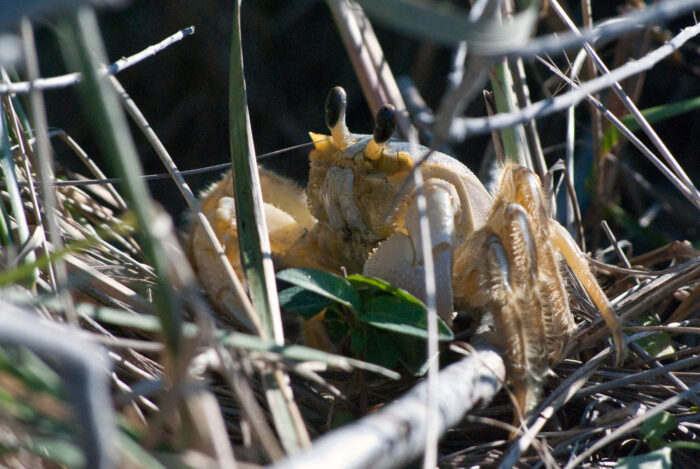Atlantic ghost crab
Ocypode quadrata
Also known as the sand crab, the Atlantic ghost crab is a sand-colored crustacean with a distinct pair of white claws. Ghost crabs are active on coastal beaches in the Chesapeake Bay region from spring through autumn.
This section shows one large critter image at a time. Use the thumbnails that follow to select a specific image to display here.

This gallery contains a grid of small thumbnails. Selecting a thumbnail will change the main image in the preceding section.
Appearance
The Atlantic ghost crab has a square-shaped, semi-translucent shell that can measure up to three inches; males are generally larger than females. These crabs are able to change their coloring to match their surroundings, making them less vulnerable to predators.
Young ghost crabs are much darker than adults, with shells colored a mottled gray and brown. These crabs have four pairs of walking legs and one pair of white claws, and their large, club-shaped eyestalks can rotate 360 degrees.
Feeding
Ghost crabs are omnivorous, feeding on insects, filter-feeders (like clams and mole crabs) and the eggs and hatchlings of loggerhead turtles. They will also scavenge for vegetation and detritus.
Predators
Common predators include raccoons, shorebirds and gulls. Ghost crabs fend off predators by darting into their burrows or flattening their bodies just under the surface of the sand.
Reproduction and life cycle
Mating can occur throughout the year, and often takes place in or near the burrow of a male. Crab burrows can be up to four feet deep, and are often found hundreds of feet from the water's edge. Younger ghost crabs burrow close to the water, while older ghost crabs burrow higher up on the beach.
While mating, males release a fluid with their sperm that will harden and prevent rival sperm from reaching the female's ova. Females carry developing eggs under their bodies before releasing them into the water, where larvae will develop. The average life span of a ghost crab is three years.
Did you know?
- The Latin name Ocypode means "swift-footed."
- Ghost crabs do not have to return to the water to wet their gills; instead, they are able to use fine hairs located on the base of their legs to wick up water from damp sand.
- Ghost crabs can create three sounds: striking the ground with their claws, rubbing their legs together or making a bubbling sound.
- More terrestrial than any other crab in the Chesapeake Bay, ghost crabs enter the water only to moisten their gills and develop eggs. Rather than enter the water completely, ghost crabs prefer to brace themselves on the sand and allow incoming waves to wash over their bodies.
Sources and additional information
- Life in the Chesapeake Bay by Alice Jane Lippson and Robert L. Lippson
- Atlantic Ghost Crab – South Carolina Department of Natural Resources
- Ocypode quadrata: Atlantic ghost crab – University of Michigan Museum of Zoology
